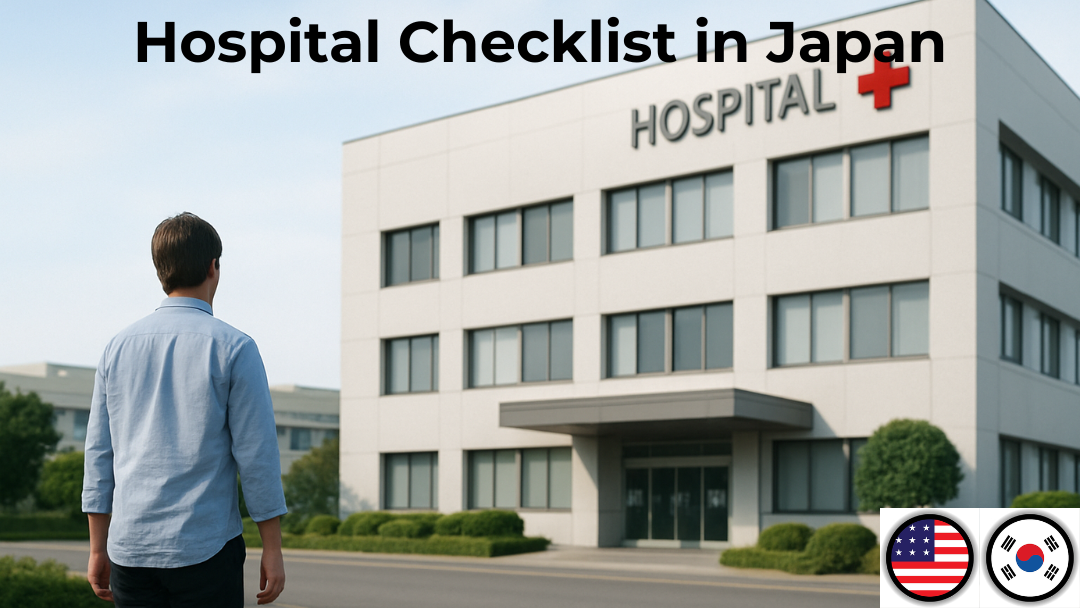In Case You Get Injured in Japan
Getting injured while living abroad can be stressful—especially when you’re unfamiliar with the local medical system. In Japan, visiting a hospital isn’t always as simple as walking in without an appointment.
해외에 거주하면서 다치는 일은 당황스럽고, 특히 의료 시스템이 익숙하지 않다면 더 혼란스러울 수 있습니다. 일본에서는 병원 방문 시 사전 예약이나 준비물이 필요한 경우가 많아, 미리 알고 대비하는 것이 중요합니다.
This post offers a practical checklist of what to do after getting injured, including how to prepare for your hospital visit, what to bring, and what to expect. Whether you’re a long-term resident or a newcomer, this guide will help you stay calm and organized in an unexpected situation.
이 글에서는 다친 후 병원에 가기 전에 준비해야 할 체크리스트를 정리했습니다.
일본에 거주 중인 분이라면, 혹시 모를 상황에 대비해 꼭 한 번 읽어두시길 추천드립니다.
What to Do After Getting Injured in Japan
1. Visit the hospital as soon as possible when you get injured
Timely treatment helps prevent infection and promotes faster wound healing.
1. 다쳤을 때는 가능한 한 빠르게 병원에 방문하세요
적절한 치료는 빠를수록 감염 예방과 상처 회복에도 좋습니다.
2. Call 119 for emergencies
Call 119 for an ambulance or fire emergency. It’s a nationwide emergency number. Ambulance rides are free of charge, but misusing them for non-emergencies is discouraged.
2. 응급 상황일 때는 119에 전화하세요
일본에서는 구급차와 화재 모두 119번으로 연결됩니다. 전국 어디서나 사용할 수 있습니다. 구급차는 무료로 이용할 수 있지만, 응급 상황이 아닐 경우에는 사용을 자제해야 합니다.
3. Use simple Japanese or English when calling an ambulance
If you’re not confident in Japanese, say “Kyūkyūsha onegaishimasu” (ambulance, please).
You can also try speaking slowly in English—many dispatchers will try to assist or connect a translator.
3. 구급차를 부를 때는 쉬운 일본어나 영어로 말해보세요
일본어가 어려운 경우에는 “큐우큐우샤 오네가이시마스(구급차 부탁합니다)”라고 말해보세요.
또박또박 영어로 설명하려고 하면, 일부 지역에서는 통역을 연결해주기도 합니다.
Checklist for a Regular Hospital Visit in Japan
1. Search for hospitals and make a reservation in advance
Without a reservation, you might face long waits or be turned away if the hospital is fully booked. Most hospitals in Japan offer online booking through their websites or medical apps, so it’s best to check in advance and secure an appointment. You can easily find hospitals using Google Maps or by searching online.
1. 병원은 미리 검색하고 예약하기
예약 없이 병원을 방문하면 대기 시간이 매우 길어지거나, 예약이 마감되어 진료를 받지 못하는 경우도 있습니다.
일본 대부분의 병원은 인터넷 또는 앱을 통해 온라인 예약이 가능하므로, 방문 전 미리 병원을 검색하고 예약해두는 것이 좋습니다. 병원 검색은 구글맵 또는 인터넷 포털을 활용하면 편리합니다.
2. Bring your My Number Card (and present it again if the month changes)
Japan is phasing out traditional health insurance cards and integrating the system with the My Number Card. Be sure to bring your My Number Card to every hospital visit.
Even for follow-up appointments, if your visit is in a new month, you may be asked to present the card again. Some hospitals may also request your residence card as ID.
2. 마이넘버카드 지참하기 (달이 바뀌면 재진 시에도 다시 제시 필요)
일본에서는 기존 건강보험증이 마이넘버카드로 통합되고 있어, 병원 방문 시 마이넘버카드를 지참해야 합니다.
재진이더라도 달이 바뀌면 다시 마이넘버카드를 제시하라고 요청받는 경우가 있으니, 매 방문 시 반드시 챙겨가세요. 또한 일부 병원에서는 신분증(예: 재류카드) 제시를 요구할 수 있습니다.
3. Arrive a bit earlier for your first visit
If it’s your first time at a hospital, you’ll need to fill out some forms (such as your medical history or personal information). Arriving 10–15 minutes early will ensure you have enough time.
3. 초진일 경우, 예약 시간보다 일찍 도착하기
처음 가는 병원에서는 간단한 문진표나 개인정보를 작성해야 합니다. 약 10~15분 정도 여유를 두고 도착하면 더 원활하게 진료를 받을 수 있습니다.
4. Bring a mask with you
Most hospitals in Japan still recommend or require wearing a mask. If you forget to bring one, you may have to buy it at the hospital.
4. 마스크 착용은 기본
일본 대부분의 병원에서는 아직도 마스크 착용을 권장하거나 요구합니다. 마스크를 착용하지 않으면 병원에서 구매 후 착용해야 할 수 있으니, 병원 방문 시 마스크를 챙겨가는 것이 좋습니다.
5. Call the hospital if you have a fever of 37°C or higher
If you have a high fever on the day of your visit, you may not be allowed to enter.
Be sure to contact the hospital in advance and follow their instructions.
5. 37도 이상 열이 날 경우 병원에 먼저 연락하기
내원 당일에 37도 이상의 고열이 있을 경우, 병원 출입이 제한될 수 있습니다.
진료 전 반드시 병원에 연락해 지침을 확인하세요.




Comments